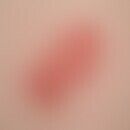Synonym(s)
HistoryThis section has been translated automatically.
DefinitionThis section has been translated automatically.
Autosomal recessive, inflammatory, palmoplantar keratosis with transition to the dorsum of the hands and feet.
You might also be interested in
Occurrence/EpidemiologyThis section has been translated automatically.
Island of Mljet, Dalmatia, Anatolia; the frequency is estimated at 1:100,000 in the general population.
EtiopathogenesisThis section has been translated automatically.
Among other things, autosomal recessive mutations of the SLURP1 gene (MDM gene), which is mapped on chromosome 8q, were described. The SLURP-1 gene encodes the SLURP1 protein (secreted mammalian Ly-6/uPAR-related protein 1). This protein can be addressed as an epidermal neuromodulator, which is important for epidermal homeostasis and inhibition of TNF-alpha release from macrophages, leading to hyperproliferation and inflammatory skin changes. It is also believed to have antitumoral activities.
ManifestationThis section has been translated automatically.
A diffuse palmoplantacreratosis can be detected shortly after birth (3-10 months), transgenic pachydermia usually occurs before the age of 3 years.
ClinicThis section has been translated automatically.
Pronounced hyperkeratoses on planar erythema. Spread of hyperkeratoses during life to dorsum of hands, knuckles, forearms, dorsum of feet and lower legs (transgrediens). In addition, brachyphalangia, hyperhidrosis, pseudoainhum syndrome, and perioral erythema may be prominent. Nail involvement such as subungual keratoses or koilonychia is common. Diffuse hyperhidrosis leads to unpleasant body odor in affected individuals.
Occasionally, the occurrence of squamous cell carcinoma and melanoma has been reported in connection with the underlying disease.
HistologyThis section has been translated automatically.
TherapyThis section has been translated automatically.
Note(s)This section has been translated automatically.
This PKK variant was first described in persons from the Adriatic island of Meleda (Mljet), hence the name.
LiteratureThis section has been translated automatically.
- Baykal C et al (2016) Unguales squamous cell carcinoma in a patient with Mal de Meleda. J Dtsch Dermatol Ges14: 514-516
- Behrend JF (1839) Iconographic depiction of non-syphilitic skin diseases. Brockhaus, Leipzig p. XV
- Charfeddine C et al (2003) A novel missens mutation in the gene encoding SLURP-1 in patients with Mal de Meleda from nothern Tunisia. Br J Dermatol 149: 1108-1115
- Eckl KM et al (2003) Mal de Meleda (MDM) caused by mutations in the gene for SLURP-1 in patients from Germany, Turkey, Palestine, and the United Arab Emirates. Hum Genet 112: 50-56
- Ergin S (2003) Mal de Meleda: a new geographical localization in Anatolia. Dermatology 206: 124-130
- Hovorka O, Ehlers E (1897) Mal de Meleda. Archive Dermatol Syphiol 44: 251-256
- Hu G et al (2003) A recurrent mutation in the ARS (component B) gene encoding SLURP-1 in Turkish families with mal de Meleda: evidence of a founder effect. J Invest Dermatol 120: 967-969
- Marrakchi S et al (2003) Novel mutations in the gene encoding secreted lymphocyte antigen-6/urokinase-type plasminogen activator receptor-related protein-1 (SLURP-1) and description of five ancestral haplotypes in patients with Mal de Meleda. J Invest Dermatol 120: 351-355
- Stulli L (1826) Di una varieta cutanea. Letter al direttore dell'Antologica - Estratti dall'Antologica di Firenze No 71-72. Firenze, pp. 1-3
- Stulli L (1828) Letter to his friend Luigi Pistorini: Sulle Detonazioni dell'isola di Meleda. Pistorini, Bologna
- Yerebakan O et al (2003) A novel mutation in the ARS (component B) gene encoding SLURP-1 in a family with Mal de Meleda. Clin Exp Dermatol 28: 542-544
Incoming links (11)
Finger ankle pads real; Hereditary koilonychia; Keratoma palmare et planttare hereditarium transgrediens; Kogoj, franjo; Mal de meleda; Mal de mljet; Meleda, disease of meleda; Mljet disease; Olmsted syndrome; Pseudoainhum syndrome; ... Show allOutgoing links (6)
Hyperhidrosis (overview); Hyperkeratoses; Keratosis palmoplantaris diffusa with mutations in KRT 9; Koilonychie; Palmoplantar keratoses (overview); Pseudoainhum syndrome;Disclaimer
Please ask your physician for a reliable diagnosis. This website is only meant as a reference.




